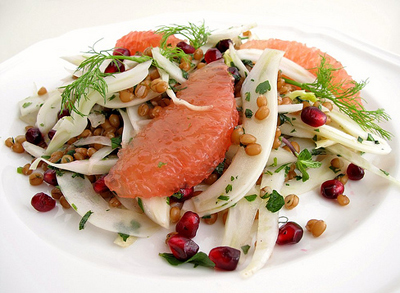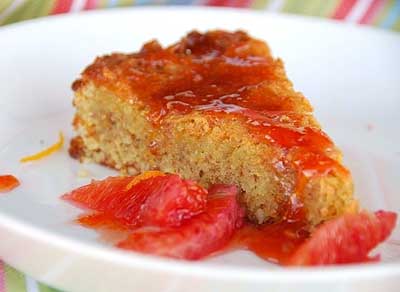 If it wasn't for citrus fruit, winter's selection of produce would be pretty sad and boring. Once you've had your share of squashes and root vegetables, it's time for something different. Citrus offers a welcome respite. When markets begin to overflow with oranges, lemons, limes, and grapefruit, things finally get exciting. You may even see unusual citruses, such as blood oranges, tangelos, and pomelos. I love them all, but I particularly adore the sweet-tart flavor of grapefruits. This time of year, they replace my apple-a-day routine. But grapefruits aren't just for a dessert or snack, they shine in savory dishes, like this salad.
If it wasn't for citrus fruit, winter's selection of produce would be pretty sad and boring. Once you've had your share of squashes and root vegetables, it's time for something different. Citrus offers a welcome respite. When markets begin to overflow with oranges, lemons, limes, and grapefruit, things finally get exciting. You may even see unusual citruses, such as blood oranges, tangelos, and pomelos. I love them all, but I particularly adore the sweet-tart flavor of grapefruits. This time of year, they replace my apple-a-day routine. But grapefruits aren't just for a dessert or snack, they shine in savory dishes, like this salad.
The classic fennel and grapefruit salad is a wonderful combination. Crunchy and sweet anise-flavored fennel goes well with the tart citrus flavor of grapefruit. This recipe reinvents the salad by adding wheat berries for a wholesome twist. The actual grains of wheat—the berries, as they are called—come in hard and soft varieties, where the hard is higher in protein and the soft higher in starch. Both work fine in this recipe. Once cooked, the berries are chewy on the outside, but tender on the inside. Enjoy them as a side dish like a pilaf or add them to any salad. They are especially nice in this recipe as they absorb the vinaigrette and grapefruit juices.
Winter
Winter
Roasted Sweet and Spicy Butternut Squash
 Another workhorse of a vegetable, Butternut Squash is always on my shopping list and in my inventory during the fall and winter months.
Another workhorse of a vegetable, Butternut Squash is always on my shopping list and in my inventory during the fall and winter months.
Sometimes it’s tucked into a curry, sometimes it’s a soup or pureed but, most of the time, it’s simply roasted with cayenne, cinnamon and salt and then drizzled with sugar free maple syrup (which has just 20 calories instead of 200!)
It’s not only a delicious side dish with dinner, it’s a satisfying snack to take on the run, or a great way to top a spinach, walnut and cranberry salad the next day. Believe it or not, I even have it for breakfast sometimes because its cinnamon-y and syrupy warmth reminds me of hot cinnamon rolls!
And this is also another one of those one oven/one time dishes which makes it easy to build your inventory!
Feeling Blue? Eat Italian Almond Torte with Blood Orange Compote
 It's March, and the weather is still pretty miserable. There are cold fronts, snow storms, dense fog, and freezing rain blanketing various parts of the country.
It's March, and the weather is still pretty miserable. There are cold fronts, snow storms, dense fog, and freezing rain blanketing various parts of the country.
While I can't make the daffodils grow any more quickly, I can share a recipe for a refreshing Italian Almond and Orange with Blood Orange Compote that is sure to make you feel warm and happy. I created the recipe a few weeks ago and have since made it two more times. It's that good.
While this Italian torte bakes, your home will be filled with the bright scent of citrus. Since it's subtly sweet yet rich with almond flavor, it's ideal for pairing with a glass of Italian Vin Santo on a relaxing afternoon. It also makes a lovely formal dessert when dressed with a spicy compote of tart blood oranges soaked in honey, vanilla, cloves, and star anise.
Finally...It's Bean Season
From the LA Times
 Some people mark the start of fall with an apple pie. Others start breaking out the big reds from their wine cellars. Me? I'm a bean boy.
Some people mark the start of fall with an apple pie. Others start breaking out the big reds from their wine cellars. Me? I'm a bean boy.
All it takes is the first sign of a nip in the air or the first morning that smells like ocean rain and I drag my Dutch oven out of the cupboard and start a big pot of beans simmering.
It doesn't really matter that I know the next day may be back up in the 90s. In fact, that uncertainty even makes it a little sweeter.
That week of rain we had at the end of September? A Portuguese-style stew of white beans with shrimp and clams, given a final lift by chopped pickled peppers.
A week or so later, after the 100-degree temperatures had lifted? White beans braised with dandelion greens and served as a bed for crisp-skinned duck breasts (the leftovers, without the duck, were just as good a couple of nights later, with a few tablespoons of grated Parmigiano-Reggiano stirred in).
Wreaths – an Outward and Visible Sign of the Season
 Frasier Fir, boxwood, magnolia, grapevine – all traditional bases for wreaths. We can pick them up at garden centers and Christmas tree vendors and even grocery stores, but sometimes it is fun to spice up ye olde wreath with some seasonal flair.
Frasier Fir, boxwood, magnolia, grapevine – all traditional bases for wreaths. We can pick them up at garden centers and Christmas tree vendors and even grocery stores, but sometimes it is fun to spice up ye olde wreath with some seasonal flair.
In December’s issue of Southern Living, I took some traditional wreaths up a notch or two to festively deck our halls, doors, windows and tables with versions of wreaths donned with a bit of Holiday zest.
Rosemary and grapefruit – two of this Farmer’s favorites! From their scents to their colors and flavors, the combo of these two can be appealing to many of the senses. Sliced grapefruit and Meyer lemons combined with Savannah holly foliage and berries on a boxwood wreath is garden glam at its best!
Add fresh cut red roses in varying shades and sizes for a boost of elegance and fragrance. The jewel tones of the fruit and flowers on the deep green base are luscious!
More Articles ...
Welcome to the new One for the Table ...
Our Home Page will be different each time you arrive.
We're sure you'll find something to pique your interest...


